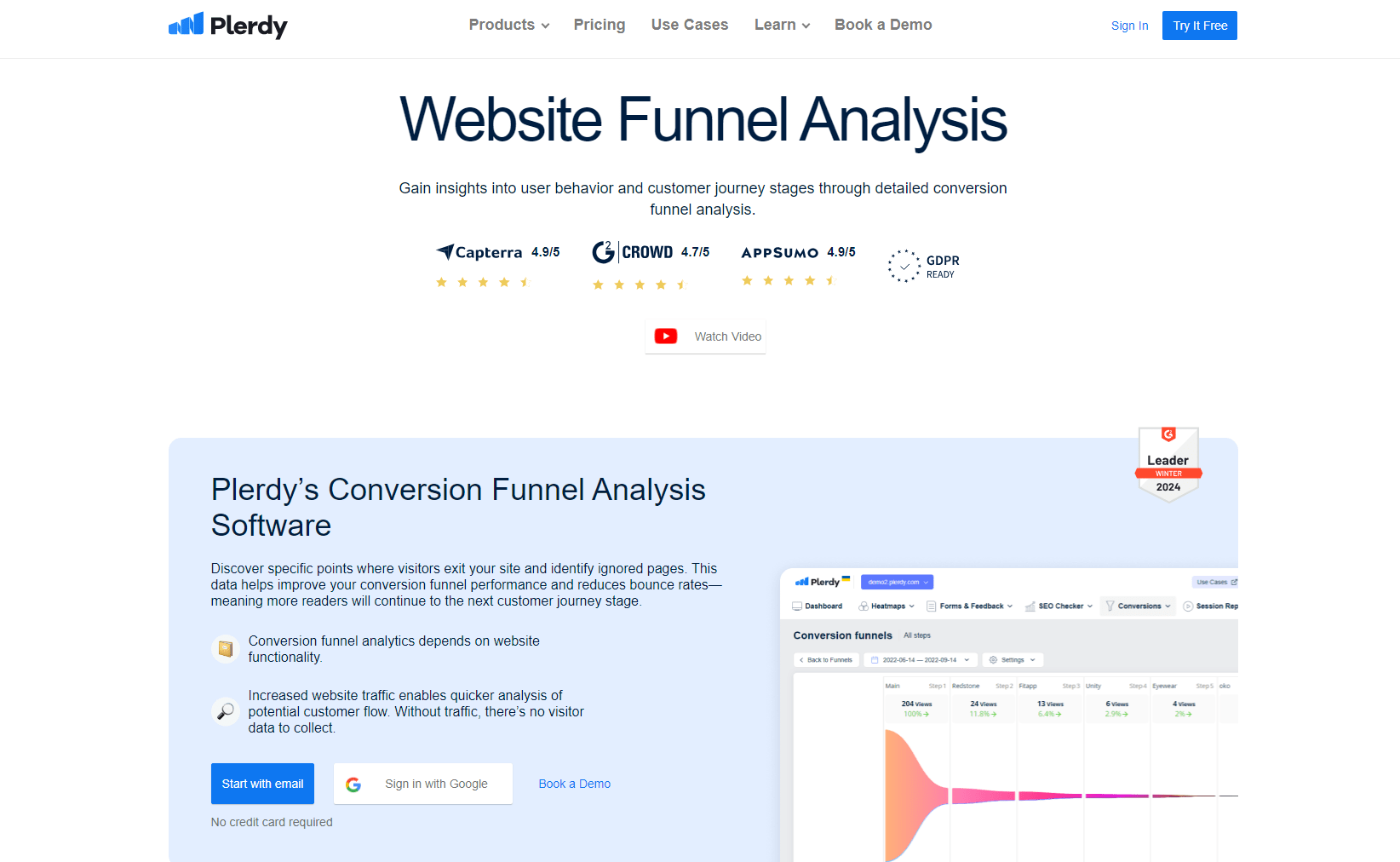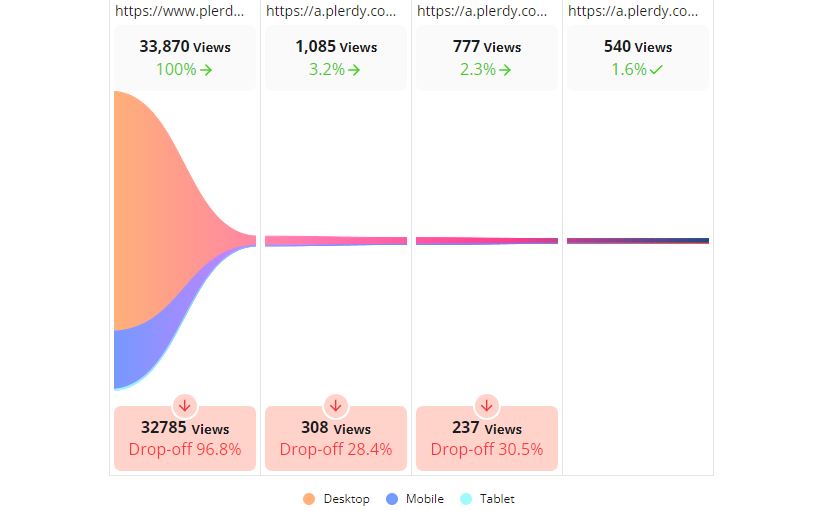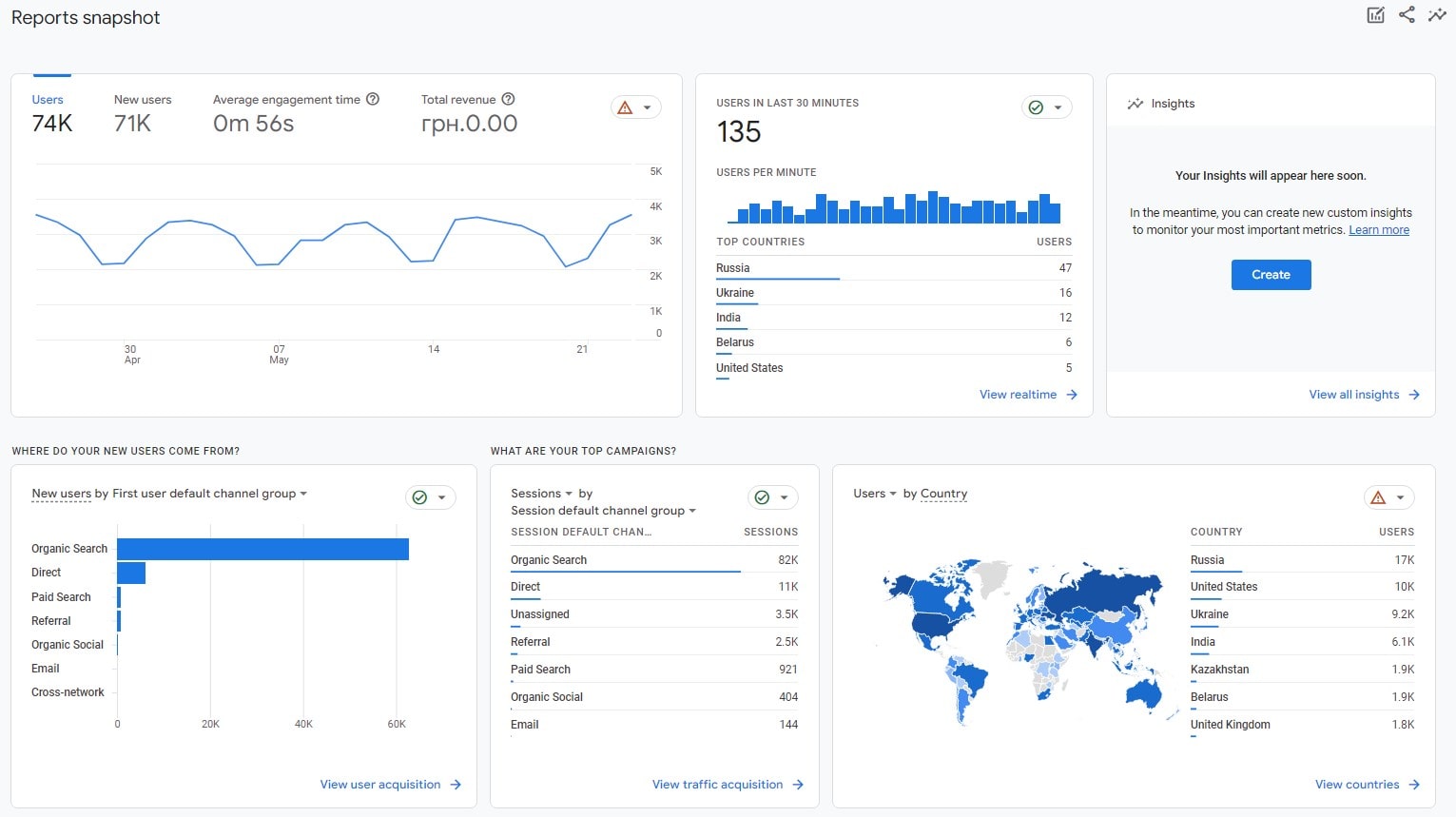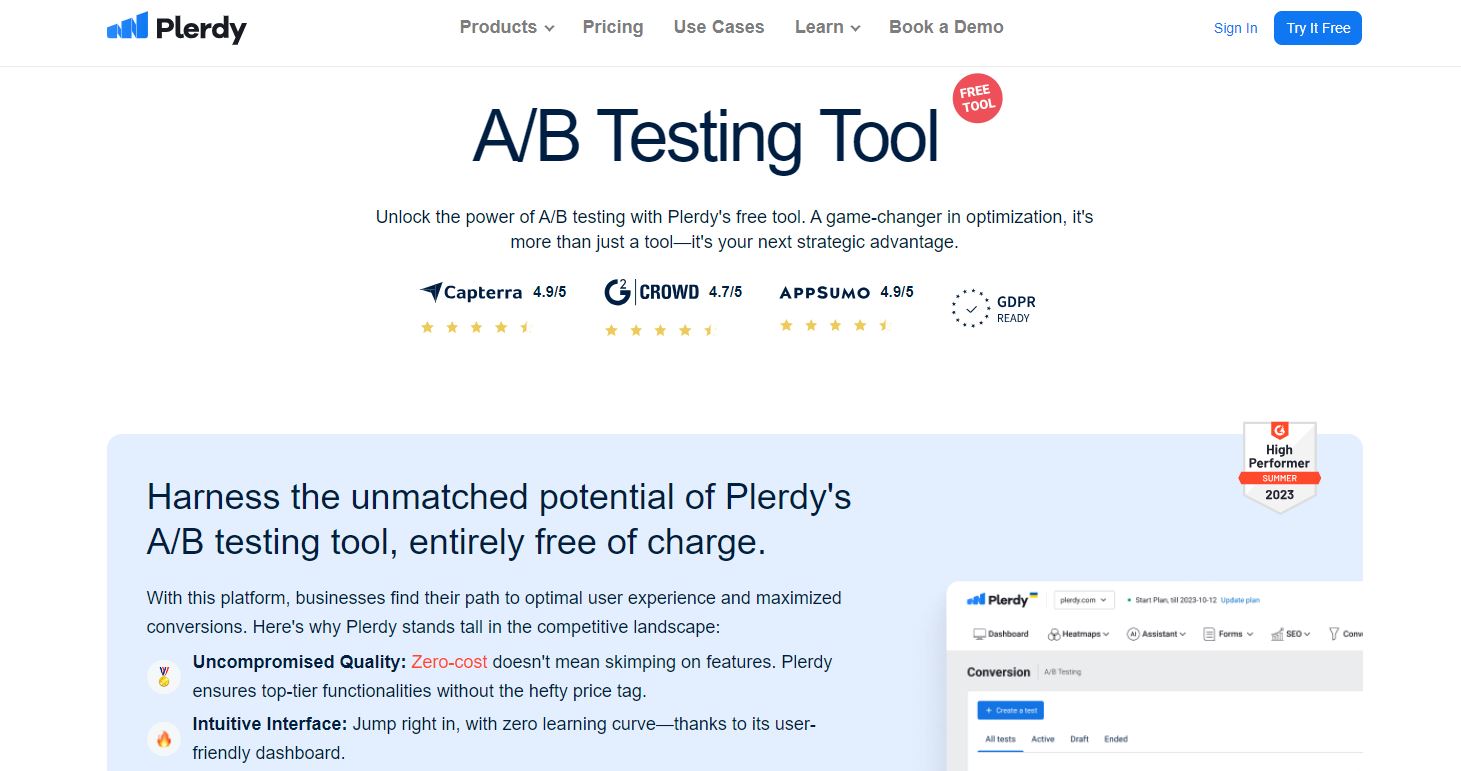Now introducing the sales funnel, the core of contemporary corporate strategy! Knowledge of sales funnel dynamics is essential in the busy digital terrain. Learning the fundamentals of a sales funnel will help you create a startup or strengthen an already-existing brand to drive your business toward even more success. explore:
- The mechanics causing sales trends to advance.
- The craft of guiding customers across every phase of a funnel.
- Using funnel techniques to increase sales
Achieving ideal sales results requires a laser attention on the complex levels of the funnel; our guide guarantees you grip on every detail. Add tools like Plerdy, an ace for CRO & UX, to augment your conversion results and complement your funnel knowledge. Get in, maximize the sales funnel, and produce strong results. Let’s start this amazing trip.
Try Plerdy today for enhanced CRO & UX insights.

Definition of a Sales Funnel
Every effective business plan is fundamentally based on the sales funnel, a methodical road map that leads possible consumers through phases until a purchase results. Companies trying to turn inquisitive surfers into devoted consumers must first understand the sales funnel.
What then is a sales funnel exactly? Imagine thus:
- A broad top signifying the large pool of prospective consumers learning of a brand or product.
- A shrinking middle that denotes a declining amount of possibilities as they go from simple interest to serious thought.
- A narrow bottom, representing the exclusive group deciding what to buy last-minute.
In the e-commerce space, for example, a consumer can first learn about a brand via a social media post (awareness), then research and check out product specs (consideration), and then add the item to their cart and check out (conversion).
Creating a flawless sales funnel guarantees a seamless transition between these levels. Every phase calls different tactics. Free workout videos might draw prospects in the fitness sector; next, customized workout regimens; then, closing the deal with a premium monthly subscription.
Important Learning Points:
- From awareness to purchase, a sales funnel arranges the path of the buyer.
- Every level calls for different techniques catered to the needs of the client.
- Examples from the fitness and e-commerce sectors show the funnel in use.
Businesses create the conditions for higher customer involvement and, finally, explosive sales by leveraging the power of a well-optimized sales funnel.
The Importance of Understanding the Sales Funnel Concept
Deep diving into the sales funnel is a compass guiding businesses to possible goldmines, not only a business plan. Apply a sales funnel for purposes beyond only quick sales. Rather, it’s a deliberate way to grasp and foster consumer interactions.
Imagine a busy café right in middle New York. At first, anyone walking by could just be attracted by the delicious scent of freshly made coffee – top of the funnel. They slide farther down the funnel as they step in and skim the menu, absorbing gourmet sandwiches and mouthwatering pastries. At last, they have finished the trip down the funnel when they settle down savouring their selected delicacy.
Understanding the sales funnel helps companies:
- Find and maximize customer touchpoints for highest involvement.
- Create personalized messages fit for the customer’s level of the funnel.
- Forecast and adjust to changes in consumer behavior, instantly refining sales plans.
To guarantee repeat business, an online bookshop might, for example, use tailored adverts for first-time visitors, customized recommendations for returning clients, and special loyalty offers.
Basically, a well-oiled sales funnel improves client relationship in addition to increasing sales. Whether in the busy streets of New York or the huge digital market, consistent development and lifelong client relationships depend on an awareness of the sales funnel idea.
The Stages of a Sales Funnel

Every business owner aims to effectively negotiate the sales funnel so that every client travels from curiosity to buy without any problems. There are several phases to this road map, each of which is essential for moving the consumer toward the sale.
Consider a hip Miami boutique hotel. Vacationers walking by would be drawn to its avant-garde architecture, which reflects the Awareness Stage. They enter the Interest Stage deeper as they explore online reviews and testimonials. They are fully in the Consideration Stage by the time they look over room choices and pricing comparisons. And they have entered the Conversion Stage straight away when they click “Book Now”.
Main Stages in a Sales Funnel:
- Potential consumers come across your brand or product during the awareness stage.
- Customers interact with material in the interest stage, looking for more specifics.
- Stage of Consideration: Consumers assess the offering and balance choices.
- The agreement is closed and the sale is complete at the conversion stage.
The funnel for a digital marketing business might start with a great blog article, then follow a webinar sign-up, a consultation request, and lastly a purchase of a service package.
Steps in the sales funnel must so be perfected. It’s the road map companies use to lead and convince consumers so they can travel from first curiosity to passionate purchase without any trouble.
Awareness Stage
The awareness stage serves as the entrance inviting possible consumers when a company starts the sales funnel road. The objective here is basic: grab the customer’s attention and stimulate their interest.
Consider a gourmet food truck out in Los Angeles’ downtown. The awareness stage in the sales funnel is essentially the delicious scent of fusion tacos filling the air as office-goers pass by makes heads turn. It’s the first spark, the first touch with a brand that sets the stage for more involved participation.
Important components of the awareness-stage:
- First impressions: Customer first impressions of the brand define the tone of next exchanges.
- Covering a large area to get as many possible prospective clients is known as broad reach.
- Using blogs, social media, or even intriguing smells to drive curiosity is engaging content.
The goal is always to attract the client, even as an artisanal coffee firm might introduce a limited-time taste or a clever song on the radio. By optimizing the awareness phase of the sales process, one may always have a constant stream of possible customers ready to discover the brand.
Interest Stage
The interest stage takes front stage, maintaining that flame alive and blazing once the sales funnel has effectively guided a potential customer through the doors of awareness. This phase focusses in on offering value, satisfying the customer’s need for more, and preparing the ground for a closer look.
Imagine Napa Valley’s boutique vineyard. Having tasted their great Cabernet at a nearby wine tasting, a consumer now searches out more about this vineyard. To indicate their move into the interest stage of the sales funnel, they investigate well chosen wine tours, study wine pairings, and dig into its past.
Highlights of the Interest Level:
- Customers delve further, consuming materials such newsletters, videos, or articles, therefore amplifying engagement.
- Customized Interaction: Companies provide particular material to fit the particular tastes of the consumer.
- By means of open policies and insightful analysis, companies build closer relationships with their consumers.
For a high-end tech brand, this can include interactive webinars highlighting product features or engaging case studies illustrating success stories. The ability of the brand to captivate, interact, and create the foundation for the customer’s move to the next major phase in the sales funnel journey defines the core of the interest stage.
Consideration Stage
Things get hot in the sales funnel at the consideration stage. Potential consumers here are not just window browsing; they are assessing items, evaluating features, and really considering a purchase. This is a turning point when companies may show how best they fit the needs of the consumer.
Think of a Manhattan premium gym. After using virtual fitness programs and workout advice, a consumer muses about a membership. All markers of entering deeply into the contemplation stage of the sales funnel, they examine class schedules, compare membership benefits, and evaluate personal trainer certifications.
Features of the Consideration Stage:
- Consumers delve into product details, customer endorsements, or service nuances.
- Potential buyers compare and contrast the brand against rivals to guarantee best value.
- Companies draw consumers in with demos, tests, or immersive events.
This may translate for a luxury skincare business into providing sample kits, highlighting before-after results, or staging expert-led skincare events. The stage of consideration is one in which the brand dances with the consumer. To lead them to the last, definitive action of purchase, this dance calls for grace, perfect timing, and a great awareness of the customer’s objectives.
Conversion Stage
The conversion stage becomes more important when the sales funnel narrows and momentum increases. This is the climax—that time when opportunities become paying consumers. This is when all the previous activities, exchanges, and value offers come together into a clear action. Companies aim for this moment, and sales success depends critically on mastering this stage.
Imagine a custom tailor working in downtown Chicago. Having experimented with different fabrics and tried on fitted coats, a client chooses to have a custom suit commissioned. All indicators of committing to a purchase and negotiating the conversion stage of the sales funnel, they choose their favorite material, talk design details, and finalize measurements.
Key Elements of the Conversion Stage:
- To further the offer, companies sometimes run limited-time specials or exclusive discounts.
- Clear communication, many payment alternatives, and seamless checkouts lead the charge.
- Assurance of after-sales services or warranties helps the buyer to make their choice.
This can mean grouping a small selection of truffles in a promotional bundle or making sure the chocolates are supplied with care and timiness for an artisanal chocolate firm. Conversion is the glorious climax for brand and customer. It is evidence of a brand’s capacity to grasp, relate to, and meet consumer expectations, therefore securing the transaction in the complex dance of business.
Retention Stage
Enter the retention stage and find a mix of customer-centric emphasis and sales techniques. These days, it’s more about keeping the customer hooked than it is about just closing a deal. Smart brands understand this difference and combine top-notch after-sales services with loyalty programs into their sales process.
Think of a Los Angeles high-end perfume boutique. Entranced by an exclusive aroma, a consumer comes back not only for a refill but also to investigate various perfumes. The boutique’s well chosen events and individualized touch—qualities of the retention stage in action—cause this repeat engagement.
Special Characteristics of the Retention Stage:
- Reward points or exclusive member discounts in loyalty programs help to encourage returning business.
- Companies aggressively solicit comments to make sure their goods or services keep satisfying consumer needs.
- Newsletters, events, and special previews help to keep consumers informed and feeling valued.
In the busy realm of craft coffee shops, a barista might provide a regular’s preferred brew or expose them to a freshly sourced bean. These apparently little gestures create relationships between consumer and brand. Fundamentally, the retention stage is about developing a relationship such that every sale serves as a link to the next interaction rather than a destination.
The Role of Content in the Sales Funnel

Content becomes the choreographer in the always changing dance between consumer wants and sales techniques. Like a brand narrative film or an instructional blog post, content gently leads prospective consumers across the sales channel.
Consider the upscale skincare market. A client can become interested when they come find a blog on the rejuvenating properties of a particular serum. This first curiosity sets off the trip across the sales process. Deeper diving reveals video testimonies and detailed product breakdowns—material catered to every level of the funnel.
Key Contributions Made by Content:
- Education: Whitepapers or how-to manuals generate brand power by their worth.
- Interactive materials—such as webinars or quizzes—help to strengthen the relationship between the company and its consumers.
- Case studies and comparison charts help to remove uncertainty and guide the consumer toward purchase.
In the world of handcrafted chocolates, a chocolatier may spin stories about finding cocoa from a certain area, then share the story via visually beautiful Instagram Stories or podcasts. It’s an experience, more than just promotion. The buyer is investing in a story, a promise, and a brand relationship by the time they reach the bottom of the sales funnel, not only purchasing a good. Content sets the tempo in this delicate ballet so that every turn, stride, and twist is exactly timed to produce a harmonic sales climax.
Measuring the Success of a Sales Funnel

Creating a dynamic sales funnel is a craft; evaluating its effectiveness explores the science of measurements. From luxury jewelry designers to massive electrical firms, every digital marketer in the e-commerce space depends on real data to understand consumer behavior inside the funnel.
Think about the custom shoe business. It’s a success if a consumer visits a homepage, finds inspiration in a tale of handcrafted leather and then registers for a newsletter. Still, a reduction in the sales process results from their leaving midway through the purchase.
Essential Measures to Evaluate Performance:
- Track client entry into the funnel and their path across it.
- Engagement Rate: Track client time on pages or frequency of interaction with material.
- Find out how many consumers progressed from simple curiosity to actual purchase.
- Project the income a consumer will bring over their lifetime.
Observing how a consumer responds to blog entries about bean origins and then moves to taste a blend is priceless information for handcrafted coffee roasters. Should a disconnect exist, it’s time to adjust the funnel. Data-driven insights guarantees that the sales funnel stays a flexible, customer-centric trip. Businesses can improve their methods by always measuring and adapting so that they don’t only attract clients; rather, they keep them involved and returning.
Key Performance Indicators (KPIs)
From upscale luxury businesses to neighborhood handcrafted bakers, every company recognizes the ability of strong KPIs to shape a clear sales funnel. These KPIs act as road signs, helping companies to grasp and improve the customer experience, hence increasing engagement and conversion power.
A digital bookshop might, for example, examine closely its sales funnel data to identify which genres pique the most customer interest. Still, the mismatch indicates a need for strategy improvement if those interested readers fail to buy.
Key KPIs to Track:
- Track the flood of possible clients pouring down the funnel.
- Focus on the interaction rate—that is, whether clicking on a promotional video or downloading an e-guide.
- Identify the proportion of consumers moving from simple interest to completed transactions.
- Comparing returning customers to one-time buyers helps you to determine your client retention rate.
Imagine a specialized skincare company. KPIs help them to identify whether consumers drop off after learning about the advantages of a serum or whether they explore user testimonials and then decide what to buy. These revelations help companies to adjust their funnel so that stage transitions are seamless. By embracing and acting upon these KPIs, businesses can create sales channels that not only appeal to their target market but also maximize the chances for expansion. Recall that in the busy market, organizations that pay close attention to KPIs will be unique and regularly provide value to their consumers.
Adjusting and Refining the Funnel
In dynamic digital marketing, inertia is not a choice. Businesses must constantly change their sales plans to guarantee the funnel stays sharp and customer-centric. Using analytics, companies can identify areas of high engagement or where possible consumers fall off at.
Think of an organic brand of coffee. After closely reviewing sales statistics, they find that although few users move to buy from their blog entries on sustainable farming generate great traffic. This realization forces the brand to change their funnel—maybe by including direct connections to purchase pages or highlighting customer endorsements just following educational material.
Steps to Improve Your Funnel:
- Examine data points to find areas needing work.
- Implement changes gradually; avoid all-at once overhauling of anything. Change one part, track its effects, then go forward.
- Compile client comments: Know what your audience wants and then adjust.
- A/B research: Create two variations of a page or advertisement and find out which one appeals to the viewers.
Businesses can make sure their sales funnels remain effective by keeping nimble and adjusting to consumer behavior. A craft beer company, for instance, might adjust its marketing content based on seasonal tastes, resulting in more engaged customers. Basically, constantly changing the sales funnel not only meets the changing wants of the client but also increases the possibility of a brand to generate significant conversions and strengthen relationships.
Common Mistakes to Avoid

Maintaining a good sales funnel isn’t like walking in a park. Given so many elements involved, companies run a risk of making mistakes. Still, knowing typical mistakes will help you maintain your funnel customer-oriented and simple.
Imagine an upscale brand of athletic apparel. They fund splashy commercials and influencer relationships lavishly. Ignoring the post-purchase portion of their funnel, however, runs the danger of losing consumers who expected ongoing involvement or assistance.
The following lists common mistakes:
- Over-Complicating Processes: Maintain a tidy sales funnel. A tech brand will turn off possible consumers if it loads visitors with complex jargon instead of streamlining its value proposition.
- Neglecting Feedback: Ignoring consumer insights can cause the provided product to differ from what the audience wants.
- Inconsistent Messaging: Companies have to speak from one voice all through the funnel. Confusion results if a skincare line alludes to luxury in one phase and cost in another.
- Skipping A/B Testing: This can cause one to stick to less successful plans, so restricting possible sales expansion.
Avoiding these traps helps companies to maximize their sales channels so that they appeal to consumers at all stages. A chain of boutique hotels, for instance, might regularly assess and improve their booking system to remove friction spots, therefore smoothing out the journey for guests and increasing bookings throughout. Perfecting is crucial, thus avoiding typical errors guarantees that the funnel of a brand stays strong and efficient.
In summary
As we have been investigating the sales funnel, we have traveled over the several tiers defining sales techniques. In the company of today, understanding the subtleties of the funnel is absolutely crucial. Every component of the funnel, from drawing in possible consumers to raising them into real conversions, is important as we have shown. Optimizing and automating the process depends on using the correct tools—like Plerdy’s SEO & UX study. Understanding your sales funnel and matching it with effective solutions like Plerdy can help you to reach best results.
Using tools and automations guarantees a simplified procedure, which will increase the conversion rates for your business. Here’s a quick review of what we discussed as we wind up:
- How might one design a successful sales funnel?
- The need of personalizing your products.
- Remaining current with the most recent trends in funnel management.
- Elegantly combining tools like Plerdy for exact analytics
In sales and funnels, each action counts. Accept the knowledge you have acquired and apply it to guide the direction of your company. All set to bring your sales funnel forward? Explore Plerdy now to release advanced UX and SEO analytics!
